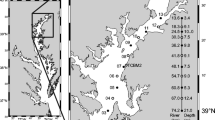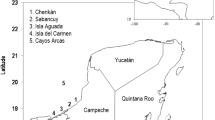Abstract
The year-class strength (YCS) of Blaufelchen (Coregonus lavaretus) in deep Upper Lake Constance was analysed for a 52-year period, from 1947 to 1998. Despite strong anthropogenic influences on the species’ population dynamics due to cultural eutrophication and oligotrophication, intense fishing, and large-scale stocking, the influence of climate variability associated with the North Atlantic Oscillation (NAO) is apparent in the data set. This influence is significant although large-scale stocking of cold-bred larvae was performed to avoid a mismatch of larvae with their food. The importance of stocking on YCS, however, is unclear and was only detectable when analysing a subset of the data. In addition to climate variability a yet unidentified factor related to zooplankton suitability as food for fish larvae, and density-dependent mortality probably related to cannibalism do significantly influence YCS. The NAO seemed to influence YCS twofold, through temperature effects on egg development time and on larval growth rate. The first of these two mechanisms is related to the NAO via a time lag of 1 year due to the specific mixing dynamics of warm monomictic Lake Constance. Hence, a warm winter in the year before spawning results in earlier hatching of larvae, that is, hatching is decoupled from the actual meteorological conditions. This should make the larvae very prone to mismatch the dynamics of their food. However, we found no evidence for such a mismatch in this 52-year data set.





Similar content being viewed by others
References
Alheit J, Hagen E (1997) Long-term climate forcing of European herring and sardine populations. Fish Oceanogr 6:130–139
Bailey KM, Houde ED (1989) Predation on eggs and larvae of marine fishes and the recruitment problem. Adv Mar Biol 25:1–83
Bäuerle E, Gaedke U (1998) Lake Constance—characterization of an ecosystem in transition. Arch Hydrobiol Spec Iss Adv Limnol 53:1–610
Braum E, Quoβ H (1981) Beobachtungen über die Entwicklung des Blaufelchens (Coregonus lavaretus wartmanni) im Bodensee-Obersee. Schweiz Z Hydrobiol 43:114–125
Burnham KP, Anderson DR (1998) Model selection and inference—a practical information-theoretic approach. Springer, Berlin Heidelberg New York
Cushing DH (1969) The regularity of the spawning season of some fishes. J Cons Int Explor Mer 185:201–213
Cushing DH (1982) Climate and fisheries. Academic Press, London
Cushing DH (1990) Plankton production and year-class strength in fish populations: an update of the match/mismatch hypotheses. Adv Mar Biol 26:249–293
Dewar RC, Watt AD (1992) Predicted changes in the synchrony of larval emergence and budburst under climatic warming. Oecologia 89:557–559
Drinkwater KF, Belgrano A, Borja A, Conversi A, Edwards M, Greene CH, Ottersen G, Pershing AJ, Walker H (2003) The response of marine ecosystems to climate variability associated with the North Atlantic Oscillation. In: Hurrell JW, Kushnir Y, Ottersen G, Visbeck M (eds) The North Atlantic Oscillation, pp 211–234
Eckmann R (1987) A comparative study on the temperature dependence of embryogenesis in three coregonids (Coregonus spp.) from Lake Constance. Schweiz Z Hydrobiol 49:353–362
Eckmann R, Pusch M (1989) The influence of temperature on growth of young coregonids (Coregonus lavaretus L.) in a large prealpine lake. Rapp P-V Reun Conserv Explor Mer 191:201–208
Eckmann R, Pusch M (1991) At what life stage is year-class strength of coregonids (Coregonus lavaretus L.) in Lake Constance determined? Verh. Int Verein Limnol 24:2465–2469
Eckmann R, Rösch R (1998) Lake Constance fisheries and fish ecology. Arch Hydrobiol Spec Iss Adv Limnol 53:285–301
Eckmann R, Rösch R, Ortlepp J, Kleifeld G (1986) Survival and growth of coregonid larvae from Lake Constance fed on zooplankton of different origin. Arch Hydrobiol Suppl Ergebn Limnol 22:203–214
Eckmann R, Gaedke U, Wetzlar HJ (1988) Effects of climatic and density-dependent factors on year-class strength of Coregonus lavaretus in Lake Constance. Can J Fish Aquat Sci 45:1088–1093
Eckmann R, Kugler M, Ruhlé C (2006) Evaluating the success of large-scale whitefish stocking at Lake Constance. Arch Hydrobiol Beih Ergebn Limnol 60 (in press)
Edwards M, Richardson AJ (2004) Impact of climate change on marine pelagic phenology and trophic mismatch. Nature 430:881–884
Elster HJ (1933) Eine Schlitten-Dredge. Int Rev Ges Hydrobiol 29:290–292
Gaedke U (1998) Functional and taxonomical properties of the phytoplankton community of large and deep Lake Constance: interannual variability and response to re-oligotrophication (1979–1993). Arch Hydrobiol Spec Iss Adv Limnol 53:119–141
Gaedke U, Ollinger D, Bäuerle E, Straile D (1998) The impact of the interannual variability in hydrodynamic conditions on the plankton development in Lake Constance in spring and summer. Arch Hydrobiol Spec Iss Adv Limnol 53:565–585
Grim J (1983) Zur Geschichte der “künstlichen Erbrütung” von Blaufelchen. Schr V G Bodensee 101:131–147
Hartmann J, Brenner T (1983) Versuch zu Kosten/Nutzen der Felchenerbrütung am Beispiel des Bodensees. Öster Fisch 36:231–234
Hartmann J, Quoβ H (1989) Gedredgte Eier, Laicherbestand, Brutanstaltquote, Jahrgangserfolg im Bodensee. Oster Fisch 42:84–87
Hurrell JW (1995) Decadal trends in the North Atlantic Oscillation: regional temperatures and precipitation. Science 269:676–679
Jüngling TM (2001) Räumlich zeitliche Verteilung und Entwicklung der Felcheneier im Bodensee sowie experimentelle Untersuchung des Erbrütungserfolges in Abhängigkeit von verschiedenen Sedimenttypen. Diploma thesis, Eberhard-Karls-Universität Tübingen
Köster F, Hinrichsen HH, St John MA, Schnack D, MacKenzie BR, Tomkiewicz J, Plikshs M (2001) Developing Baltic cod recruitment models. II. Incorporation of environmental variability and species interaction. Can J Fish Aquat Sci 58:1534–1556
Miller TJ, Crowder LB, Rice JA, Marschall EA (1988) Larval size and recruitment mechanisms in fishes—toward a conceptual framework. Can J Fish Aquat Sci 45:1657–1670
Nümann W (1967) Ungewollte und gezielte Eingriffe in die Populationsdynamik der Blaufelchen. Arch Fischereiwissensch 18:12–24
Nümann W, Quoβ H (1972) Strudelwürmer dezimieren den Felchenlaich—Ursachen für die unterschiedlichen Fangerträge in der Blaufelchen-Fischerei des Bodensees. Fischwirt 22:25–27
Ottersen G, Loeng H (2000) Covariability in early growth and year-class strength of Barents Sea cod, haddock, and herring: the environmental link. ICES J Mar Sci 57:339–348
Ottersen G, Alheit J, Drinkwater KF, Friedland K, Hagen E, Stenseth NC (2004) The responses of fish populations to ocean climate fluctuations. In: Stenseth NC (ed) Ecological impacts of the North Atlantic Oscillation on North Atlantic ecosystems. Oxford University Press, Oxford, pp 73–94
Rossknecht H (1998) Langjährige Entwicklung chemischer Parameter im Bodensee-Obersee. Ber Int Gewässerschutzkomm Bodensee 48:1–137
SAS Institute (1988) SAS/STAT user’s guide, release 6.03 edition. SAS Institute, Cary, N.C.
Schindler DE, Rogers DE, Scheuerell MD, Abrey CA (2005) Effects of changing climate on zooplankton and juvenile sockeye salmon growth in southwestern Alaska. Ecology 86:198–209
Straile D (2000) Meteorological forcing of plankton dynamics in a large and deep continental European lake. Oecologia 122:44–50
Straile D, Geller W (1998) Crustacean zooplankton in Lake Constance from 1920 to 1995: response to eutrophication and reoligotrophication. Arch Hydrobiol Spec Iss Adv Limnol 53:255–274
Straile D, Joehnk K, Rossknecht H (2003) Complex effects of winter warming on the physico-chemical characteristics of a deep lake. Limnol Oceanogr 48:1432–1438
Sundby S, Ellertsen B, Fossum P (1994) Encounter rates between first-feeding cod larvae and their prey during moderate to strong turbulent mixing. ICES J Mar Sci Symp 198:393–405
Visser ME, Both C (2005) Shifts in phenology due to global climate change: the need for a yardstick. Proc R Soc B Biol Sci 272:2561–2569
Visser ME, van Nordwijk J, Tinbergen JM, Lessels CM (1998) Warmer springs lead to mistimed reproduction in great tits (Parus major). Proc R Soc Lond B 265:1867–1870
Walz N, Elster HJ, Mezger M (1987) The development of the rotifer community structure in Lake Constance during its eutrophication. Arch Hydrobiol Suppl 74:452–487
Weisse T, Müller H, Pinto-Coelho RM, Schweizer A, Springmann D, Baldringer G (1990) Response of the microbial loop to the phytoplankton spring bloom in a large prealpine lake. Limnol Oceanogr 35:781–794
Acknowledgements
We thank Henno Rossknecht and Michael Kugler for providing data on water temperatures and whitefish YCS, and two anonymous reviewers for their valuable comments. This research was supported by the European Union Environment and Climate project CLIME (EVK1-CT-2002–00121) and the Deutsche Forschungsgemeinschaft within the priority program 1162 AQUASHIFT.
Author information
Authors and Affiliations
Corresponding author
Additional information
Communicated by Ulrich Sommer.
Rights and permissions
About this article
Cite this article
Straile, D., Eckmann, R., Jüngling, T. et al. Influence of climate variability on whitefish (Coregonus lavaretus) year-class strength in a deep, warm monomictic lake. Oecologia 151, 521–529 (2007). https://doi.org/10.1007/s00442-006-0587-9
Received:
Accepted:
Published:
Issue Date:
DOI: https://doi.org/10.1007/s00442-006-0587-9




